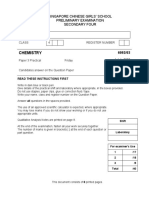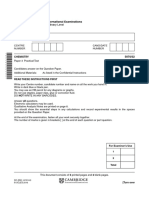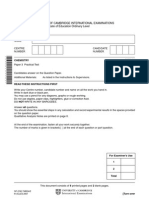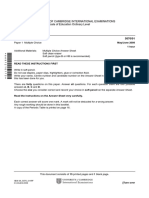Chemistry: University of Cambridge International Examinations General Certificate of Education Ordinary Level
Chemistry: University of Cambridge International Examinations General Certificate of Education Ordinary Level
Uploaded by
mstudy123456Copyright:
Available Formats
Chemistry: University of Cambridge International Examinations General Certificate of Education Ordinary Level
Chemistry: University of Cambridge International Examinations General Certificate of Education Ordinary Level
Uploaded by
mstudy123456Original Title
Copyright
Available Formats
Share this document
Did you find this document useful?
Is this content inappropriate?
Copyright:
Available Formats
Chemistry: University of Cambridge International Examinations General Certificate of Education Ordinary Level
Chemistry: University of Cambridge International Examinations General Certificate of Education Ordinary Level
Uploaded by
mstudy123456Copyright:
Available Formats
This document consists of 8 printed pages.
SJF3671 T11532/2
UCLES 2006 [Turn over
UNIVERSITY OF CAMBRIDGE INTERNATIONAL EXAMINATIONS
General Certificate of Education Ordinary Level
CHEMISTRY 5070/03
Paper 3 Practical Test
October/November 2006
1 hour 30 minutes
Candidates answer on the Question Paper.
Additional Materials: As listed in the Instructions to Supervisors.
READ THESE INSTRUCTIONS FIRST
Write your Centre number, candidate number and name on all the work you hand in.
Write in dark blue or black pen.
You may use a pencil for any diagrams, graphs or rough work.
Do not use staples, paper clips, highlighters, glue or correction fluid.
Answer all questions.
Qualitative analysis notes are printed on page 8.
You should show the essential steps in any calculation and record experimental results in the spaces
provided on the question paper.
At the end of the examination, fasten your work securely together.
The number of marks is given in brackets [ ] at the end of each question or part question.
Centre Number Candidate Number Name
For Examiners Use
1
2
TOTAL
2
5070/03/O/N/06
1 Hydrogen peroxide, H
2
O
2
, is a widely used bleach.
Solution P is acidified hydrogen peroxide and you are to determine its concentration by
titrating it with potassium manganate(VII).
No indicator is necessary since the products of the reaction are almost colourless and one
drop of potassium manganate(VII) in excess produces an easily seen pale pink colour.
Solution Q is 0.0200 mol/dm
3
potassium manganate(VII), KMnO
4
.
(a) Fill the burette with solution Q. Because the colour of Q is so intense, you may find it
easier to read the top of the meniscus.
Pipette a 25.0 cm
3
(or 20.0 cm
3
) portion of P into a flask and titrate with Q. At first the
purple colour disappears rapidly. As the titration proceeds, this disappearance is less
rapid. At the end-point, one drop of Q produces a pink colour that does not disappear
on swirling.
Record your results in the table, repeating the titration as many times as you consider
necessary to achieve consistent results.
Results
Burette readings
Summary
Tick () the best titration results.
Using these results, the average volume of Q required was cm
3
.
Volume of P used was cm
3
. [12]
For
Examiners
Use
UCLES 2006
titration number 1 2
final reading / cm
3
initial reading / cm
3
volume of Q used / cm
3
best titration results ()
3
5070/03/O/N/06 [Turn over
(b) Q is 0.0200 mol/dm
3
potassium manganate(VII).
Five moles of hydrogen peroxide react with two moles of potassium manganate(VII).
Using your results from (a), calculate the concentration, in mol/dm
3
, of the hydrogen
peroxide in P.
Concentration of hydrogen peroxide in P is mol/dm
3
. [2]
For
Examiners
Use
UCLES 2006
4
5070/03/O/N/06
2 R and S are solutions of two sodium salts. Carry out the following tests and record your
observations in the table. You should test and name, where possible, any gases evolved.
After testing the gases, discard the mixtures and wash out the test-tubes. You are not
expected to identify R and S.
Tests on R
For
Examiners
Use
UCLES 2006
test
no.
1
2
3
test
To a portion of R, add a few drops of
concentrated hydrochloric acid and
warm the mixture gently.
To a portion of acidified aqueous
potassium manganate(VII), add an equal
volume of R.
(a) To a portion of R, add a few drops
of aqueous potassium iodide.
(b) Carefully add an equal volume of
dilute hydrochloric acid to the
mixture from (a).
observations
5
5070/03/O/N/06 [Turn over
[13]
For
Examiners
Use
UCLES 2006
test
no.
4
test
(a) To a portion of R, add an equal
volume of aqueous iron(II)
sulphate.
5 To a portion of R, add an equal volume of
aqueous sodium hydroxide and a piece
of aluminium foil. Warm the mixture
gently.
(b) Warm the mixture from (a) gently.
(c) When no further reaction takes
place, allow the mixture from (b) to
cool. Then, to a portion of this
mixture, add aqueous sodium
hydroxide until a change is seen.
observations
6
5070/03/O/N/06
Tests on S
[10]
For
Examiners
Use
UCLES 2006
test
no.
6
test
To a portion of acidified aqueous
potassium manganate(VII), add an equal
volume of S.
observations
7
8
9
To a portion of S, add a few drops of
aqueous potassium iodide.
(a) To a portion of S, add an equal
volume of aqueous barium nitrate.
(a) To a small portion of aqueous
iron(III) chloride, add three times
the volume of S. Divide this mixture
into two portions.
(c) To the other portion of the mixture
from (a), add an equal volume of
dilute hydrochloric acid and warm
gently. Allow this mixture to cool
and then add aqueous sodium
hydroxide until a change is seen.
(b) Add dilute hydrochloric acid to the
mixture from (a).
(b) Warm one of the portions of the
mixture from (a) gently.
7
5070/03/O/N/06
Conclusions
Substances can be classified as only oxidising agents, only reducing agents, both oxidising and
reducing agents or neither oxidising nor reducing agents. Using your results, tick the appropriate
box to classify R and the appropriate box to classify S.
An element present in the anion in R is [3]
For
Examiners
Use
UCLES 2006
only an oxidising agent
R S
only a reducing agent
both an oxidising agent and a reducing agent
neither an oxidising agent nor a reducing agent
8
5070/03/O/N/06
NOTES FOR USE IN QUALITATIVE ANALYSIS
Tests for anions
Tests for aqueous cations
Tests for gases
UCLES 2006
anion
cation
gas test and test result
turns damp red litmus paper blue
turns limewater milky
bleaches damp litmus paper
pops with a lighted splint
relights a glowing splint
turns aqueous potassium dichromate(VI) from orange to green
ammonia (NH
3
)
carbon dioxide (CO
2
)
chlorine (Cl
2
)
hydrogen (H
2
)
oxygen (O
2
)
sulphur dioxide (SO
2
)
effect of aqueous sodium hydroxide effect of aqueous ammonia
white ppt., soluble in excess giving a
colourless solution
white ppt., insoluble in excess
ammonia produced on warming
white ppt., insoluble in excess no ppt. or very slight white ppt.
light blue ppt., insoluble in excess light blue ppt., soluble in excess giving
a dark blue solution
green ppt., insoluble in excess green ppt., insoluble in excess
red-brown ppt., insoluble in excess red-brown ppt., insoluble in excess
white ppt., soluble in excess giving a
colourless solution
white ppt., soluble in excess giving a
colourless solution
aluminium (Al
3
+
)
ammonium (NH
4
+
)
calcium (Ca
2
+
)
copper(II) (Cu
2
+
)
iron(II) (Fe
2
+
)
iron(III) (Fe
3
+
)
zinc (Zn
2
+
)
carbonate (CO
2
3
)
chloride (Cl
)
[in solution]
iodide (I
)
[in solution]
nitrate (NO
3
)
[in solution]
sulphate (SO
2
4
)
[in solution]
test
add dilute acid
acidify with dilute nitric acid, then add
aqueous silver nitrate
acidify with dilute nitric acid, then add
aqueous lead(II) nitrate
add aqueous sodium hydroxide then
aluminium foil; warm carefully
acidify with dilute nitric acid, then add
aqueous barium nitrate
test result
effervescence, carbon dioxide
produced
white ppt.
yellow ppt.
ammonia produced
white ppt.
Permission to reproduce items where third-party owned material protected by copyright is included has been sought and cleared where possible. Every
reasonable effort has been made by the publisher (UCLES) to trace copyright holders, but if any items requiring clearance have unwittingly been included, the
publisher will be pleased to make amends at the earliest possible opportunity.
University of Cambridge International Examinations is part of the University of Cambridge Local Examinations Syndicate (UCLES), which is itself a department of
the University of Cambridge.
You might also like
- Solution Manual For Electronic Principles 8th Edition by Malvino Chapters 1 22 PDFDocument6 pagesSolution Manual For Electronic Principles 8th Edition by Malvino Chapters 1 22 PDFWaseem Hassan18% (17)
- Ohm's and Kirchoff's Law Lab ReportDocument11 pagesOhm's and Kirchoff's Law Lab ReportRelu CosteaNo ratings yet
- University of Cambridge International Examinations General Certificate of Education Ordinary LevelDocument8 pagesUniversity of Cambridge International Examinations General Certificate of Education Ordinary Levelmstudy123456No ratings yet
- Chemistry: University of Cambridge International Examinations General Certificate of Education Ordinary LevelDocument8 pagesChemistry: University of Cambridge International Examinations General Certificate of Education Ordinary Levelmstudy123456No ratings yet
- University of Cambridge International Examinations General Certificate of Education Ordinary LevelDocument8 pagesUniversity of Cambridge International Examinations General Certificate of Education Ordinary Levelmstudy123456No ratings yet
- Question Olevel BioDocument8 pagesQuestion Olevel BioMahiNo ratings yet
- 5070 w03 QP 3Document8 pages5070 w03 QP 3mstudy123456No ratings yet
- 5070 s09 QP 3Document8 pages5070 s09 QP 3Sherlock Wesley ConanNo ratings yet
- 0620 - s08 - QP - 5 Past PaperDocument8 pages0620 - s08 - QP - 5 Past PaperMatthew LiNo ratings yet
- University of Cambridge International Examinations International General Certificate of Secondary Education ChemistryDocument8 pagesUniversity of Cambridge International Examinations International General Certificate of Secondary Education ChemistryHaider AliNo ratings yet
- SCGS 2022 Prelim Chemistry P3 QPDocument8 pagesSCGS 2022 Prelim Chemistry P3 QPVictor Lee100% (1)
- Cambridge Ordinary LevelDocument8 pagesCambridge Ordinary LevelHammad hassanNo ratings yet
- Paper 3 Nov 2008Document8 pagesPaper 3 Nov 2008MSHNo ratings yet
- University of Cambridge International Examinations International General Certificate of Secondary Education Chemistry Paper 6 Alternative To Practical October/November 2004 1 HourDocument12 pagesUniversity of Cambridge International Examinations International General Certificate of Secondary Education Chemistry Paper 6 Alternative To Practical October/November 2004 1 HourAbd Razak SafianNo ratings yet
- 6 Chem IiiDocument9 pages6 Chem IiiW. Joseph the chemistNo ratings yet
- 9701 Y07 SP 31Document18 pages9701 Y07 SP 31Mohsin SadiqNo ratings yet
- Cambridge Ordinary LevelDocument8 pagesCambridge Ordinary LeveliramtahiraNo ratings yet
- 5070 w05 QP 4Document16 pages5070 w05 QP 4mstudy123456No ratings yet
- 9701 Y07 SP 31Document18 pages9701 Y07 SP 31gm_beacon0% (1)
- SP 2007 (3-5)Document52 pagesSP 2007 (3-5)Maheer100% (1)
- ChemistryDocument20 pagesChemistryrabtay100% (1)
- Chem Pp3 'A' LevelDocument10 pagesChem Pp3 'A' Levelowekajohnbosco678No ratings yet
- 2016 Specimen Paper 3Document12 pages2016 Specimen Paper 3MaheerNo ratings yet
- Edexcel GCE: ChemistryDocument12 pagesEdexcel GCE: ChemistryUncleBulgariaNo ratings yet
- Edexcel GCE: ChemistryDocument12 pagesEdexcel GCE: ChemistryUncleBulgariaNo ratings yet
- Ocr 33981 PP 09 Jan L Gce 2813 03Document8 pagesOcr 33981 PP 09 Jan L Gce 2813 03Philip_830No ratings yet
- S6 - 173 - 2016 01 01 12 08 01Document7 pagesS6 - 173 - 2016 01 01 12 08 01Yawe FrancisNo ratings yet
- A Levels Chemistry November 2012 Question Paper 31Document16 pagesA Levels Chemistry November 2012 Question Paper 31Dhakal SauhardaNo ratings yet
- 0620 s04 QP 6Document12 pages0620 s04 QP 6Haider AliNo ratings yet
- Chemistry: University of Cambridge International Examinations General Certificate of Education Ordinary LevelDocument8 pagesChemistry: University of Cambridge International Examinations General Certificate of Education Ordinary LevellearnerNo ratings yet
- Marking Scheme For Prelim Practical 2015 QN 1Document5 pagesMarking Scheme For Prelim Practical 2015 QN 1FangZiWenNo ratings yet
- November 2020 Question Paper 32Document8 pagesNovember 2020 Question Paper 32Minnie SunshineNo ratings yet
- Science Practical Test 1Document2 pagesScience Practical Test 1Rodgers PrincipleNo ratings yet
- 5070 s10 QP 41Document30 pages5070 s10 QP 41G M Ali KawsarNo ratings yet
- Chemistry (IGCSE) 0620 - s07 - QP - 6Document16 pagesChemistry (IGCSE) 0620 - s07 - QP - 6Drizzle0% (1)
- IGCSE Chem Summer 2016 Question Paper 63Document12 pagesIGCSE Chem Summer 2016 Question Paper 63rNo ratings yet
- University of Cambridge International Examinations International General Certifi Cate of Secondary EducationDocument8 pagesUniversity of Cambridge International Examinations International General Certifi Cate of Secondary EducationSumaira AliNo ratings yet
- f3 Chem Pp3 C-HR 10 QPDocument77 pagesf3 Chem Pp3 C-HR 10 QPStephen MucheruNo ratings yet
- 2816/03/TEST: Advanced Gce ChemistryDocument12 pages2816/03/TEST: Advanced Gce ChemistryPhilip_830No ratings yet
- 5070 w06 QP 4Document31 pages5070 w06 QP 4G M Ali KawsarNo ratings yet
- S.6 Chem IiiDocument9 pagesS.6 Chem IiiW. Joseph the chemistNo ratings yet
- Aqa 2420 W TRB Psa10Document7 pagesAqa 2420 W TRB Psa10KelumNo ratings yet
- Chemistry AS Unit 3 June 2008Document16 pagesChemistry AS Unit 3 June 2008Ahmed Osama AbdellatifNo ratings yet
- 9701 w13 QP 35 2 PDFDocument12 pages9701 w13 QP 35 2 PDFNeural Spark Physics CieNo ratings yet
- 9701 s11 QP 35 PDFDocument16 pages9701 s11 QP 35 PDFNeural Spark Physics CieNo ratings yet
- University of Cambridge International Examinations General Certificate of Education Ordinary LevelDocument20 pagesUniversity of Cambridge International Examinations General Certificate of Education Ordinary Levelmstudy123456No ratings yet
- 5070 s04 QP 1Document16 pages5070 s04 QP 1mstudy123456No ratings yet
- Copper Tit RationsDocument4 pagesCopper Tit RationsArief GatotNo ratings yet
- Practical Paper 4questions - 1 PDFDocument78 pagesPractical Paper 4questions - 1 PDFhiyaa 15-15No ratings yet
- Cambridge O Level: CHEMISTRY 5070/32Document8 pagesCambridge O Level: CHEMISTRY 5070/32Hyper GamerNo ratings yet
- Cation III Part BDocument6 pagesCation III Part BRenan RodriguesNo ratings yet
- CIE O Level 2008 ChemistryDocument16 pagesCIE O Level 2008 ChemistrysandeepdarkngihtsNo ratings yet
- Planning Paper 3Document12 pagesPlanning Paper 3Hamdan MushoddiqNo ratings yet
- Edexcel AS Chemistry Unit4 Jan 2013Document28 pagesEdexcel AS Chemistry Unit4 Jan 2013Pakorn WinayanuwattikunNo ratings yet
- University of Cambridge International Examinations International General Certifi Cate of Secondary EducationDocument12 pagesUniversity of Cambridge International Examinations International General Certifi Cate of Secondary EducationHaider AliNo ratings yet
- 5070 s04 QP 4Document16 pages5070 s04 QP 4mstudy123456No ratings yet
- O Level Biology Practice For Structured Questions RespirationFrom EverandO Level Biology Practice For Structured Questions RespirationRating: 4 out of 5 stars4/5 (2)
- Advanced Pharmaceutical analysisFrom EverandAdvanced Pharmaceutical analysisRating: 4.5 out of 5 stars4.5/5 (2)
- Gas Hydrates 1: Fundamentals, Characterization and ModelingFrom EverandGas Hydrates 1: Fundamentals, Characterization and ModelingDaniel BrosetaNo ratings yet
- 0654 w04 Ms 6Document6 pages0654 w04 Ms 6mstudy123456No ratings yet
- 0547 s06 TN 3Document20 pages0547 s06 TN 3mstudy123456No ratings yet
- 0486 w09 QP 4Document36 pages0486 w09 QP 4mstudy123456No ratings yet
- Literature (English) : International General Certificate of Secondary EducationDocument1 pageLiterature (English) : International General Certificate of Secondary Educationmstudy123456No ratings yet
- Frequently Asked Questions: A/AS Level Sociology (9699)Document1 pageFrequently Asked Questions: A/AS Level Sociology (9699)mstudy123456No ratings yet
- University of Cambridge International Examinations General Certificate of Education Advanced LevelDocument2 pagesUniversity of Cambridge International Examinations General Certificate of Education Advanced Levelmstudy123456No ratings yet
- 9694 w10 QP 23Document8 pages9694 w10 QP 23mstudy123456No ratings yet
- 9694 s11 QP 21Document8 pages9694 s11 QP 21mstudy123456No ratings yet
- 8780 w12 QP 1Document16 pages8780 w12 QP 1mstudy123456No ratings yet
- English Language: PAPER 1 Passages For CommentDocument8 pagesEnglish Language: PAPER 1 Passages For Commentmstudy123456No ratings yet
- 8693 English Language: MARK SCHEME For The October/November 2009 Question Paper For The Guidance of TeachersDocument4 pages8693 English Language: MARK SCHEME For The October/November 2009 Question Paper For The Guidance of Teachersmstudy123456No ratings yet
- 9719 SPANISH 8685 Spanish Language: MARK SCHEME For The May/June 2009 Question Paper For The Guidance of TeachersDocument3 pages9719 SPANISH 8685 Spanish Language: MARK SCHEME For The May/June 2009 Question Paper For The Guidance of Teachersmstudy123456No ratings yet
- 8679 w04 ErDocument4 pages8679 w04 Ermstudy123456No ratings yet
- First Language Spanish: Paper 8665/22 Reading and WritingDocument6 pagesFirst Language Spanish: Paper 8665/22 Reading and Writingmstudy123456No ratings yet
- Microsoft PowerPoint - SoC Design Flow Tools CodesignDocument110 pagesMicrosoft PowerPoint - SoC Design Flow Tools CodesignRathan NNo ratings yet
- Links and NavigationDocument16 pagesLinks and NavigationJbr RaheemNo ratings yet
- Francis Goya Tenderness Tabs PDFDocument5 pagesFrancis Goya Tenderness Tabs PDFaaNo ratings yet
- Water Flooding in The PEM Fuel CellsDocument10 pagesWater Flooding in The PEM Fuel CellsvijaysolomonNo ratings yet
- Analaytical Chemistry Module 2Document50 pagesAnalaytical Chemistry Module 2May Joy VasquezNo ratings yet
- 2005-021 MotwaniDocument6 pages2005-021 Motwanialexander100% (1)
- Imrana Ashraf Zahid: Quaid-i-Azam University Islamabad PakistanDocument116 pagesImrana Ashraf Zahid: Quaid-i-Azam University Islamabad Pakistanchibssa alemayehuNo ratings yet
- Guide Convolutional Neural Network CNNDocument25 pagesGuide Convolutional Neural Network CNNfaisal100% (1)
- CH-01 30HXC-175Document2 pagesCH-01 30HXC-175Usman ShaikhNo ratings yet
- Orange Research Catalog SmallDocument32 pagesOrange Research Catalog SmallLuz Stella Calixto GomezNo ratings yet
- Engineering Physics Notes PDFDocument242 pagesEngineering Physics Notes PDFpostmanZZNo ratings yet
- Arbaminch University JornalDocument12 pagesArbaminch University JornalmahedreNo ratings yet
- NotsablosomDocument318 pagesNotsablosomசிவசங்கர் முத்துமல்லுNo ratings yet
- J Rser 2016 06 059Document13 pagesJ Rser 2016 06 059korope8705No ratings yet
- Low NoiseamplifierDocument115 pagesLow NoiseamplifierVedran IbrahimovicNo ratings yet
- Woodwork Exam2 PDFDocument8 pagesWoodwork Exam2 PDFROSNo ratings yet
- Femoral Neck FracturesDocument8 pagesFemoral Neck FracturesMorshed Mahbub AbirNo ratings yet
- Hydrology Lecture 5 10.28.2019 PDFDocument70 pagesHydrology Lecture 5 10.28.2019 PDFMariette LeeNo ratings yet
- Ada KruskalDocument8 pagesAda KruskalachyuthaNo ratings yet
- Nouf HW2Document4 pagesNouf HW2noufNo ratings yet
- HW 1.3 Linear Regression CorrelationDocument3 pagesHW 1.3 Linear Regression Correlationantonio.lealNo ratings yet
- NCR 1021Document39 pagesNCR 1021Ali KayaNo ratings yet
- UV/Ozone Cleaning of Surfaces: Journal of Vacuum Science & Technology A Vacuum Surfaces and Films June 1985Document7 pagesUV/Ozone Cleaning of Surfaces: Journal of Vacuum Science & Technology A Vacuum Surfaces and Films June 1985chirag vyasNo ratings yet
- 2.2 Grain Size Distribution: Sieve AnalysisDocument20 pages2.2 Grain Size Distribution: Sieve AnalysisYen Ling NgNo ratings yet
- Mini Max AlgorithmDocument31 pagesMini Max AlgorithmSharanya EmmadisettyNo ratings yet
- Datasheet: Release Date: 10 Revision Number: 1.7Document4 pagesDatasheet: Release Date: 10 Revision Number: 1.7VICTOR PEREZNo ratings yet
- Problem Set 1: Introduction To R - Solutions With R Output: 1 Install PackagesDocument24 pagesProblem Set 1: Introduction To R - Solutions With R Output: 1 Install PackagesDarnell LarsenNo ratings yet
- Frame Scaffolding: The Leader in Scaffold ServicesDocument16 pagesFrame Scaffolding: The Leader in Scaffold ServicesrisaNo ratings yet







































































































